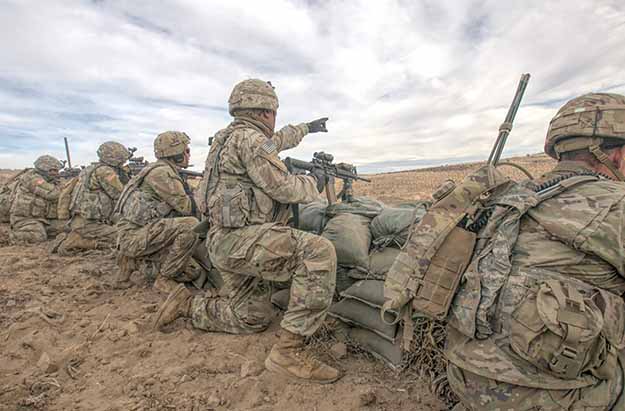Sgt. Cuatro Ramirez watched as Spc. Austin Donnelly and PV2 John Springer did a dozen push-ups in the sage and sand of the Yakima Training Center.
"They are eager to learn and to work," Ramirez said, "and most important they are confident and motivated; they are outstanding soldiers."
"It's pretty high speed," commented Donnelly as he caught his breath.
"Yeah," added Springer as he got up, "because we're in the best platoon on station."
The three are assigned to 1st Battalion, 23rd Infantry Regiment, 1st Stryker Brigade Combat Team (SBCT), 2nd Infantry Division which since early October has been engaged in Bayonet Focus, a realistic combat focused training exercise that test the spectrum of combat operations. The unit will return to Joint Base Lewis-McChord near the end of the month.
In early 2022 the battalion will deploy to the National Training Center for more training.
"We've trained as though this were an actual deployment," commented Maj. Dick Tallman, the battalion's executive officer.
"From ground conveys and air assault missions to company level situation training exercises to the gunnery practice and platoon live fire exercises, we've tested all our systems and these soldiers are performing very well."
But the key metric by which a unit's readiness is measured is how well it performs in a fire and maneuver scenario.
"The bread and butter of what we do is live fire," stated battalion CSM Joseph Nicholson as 3rd Platoon, Blackhawk Company prepared to roll out in a convoy of five Strykers with the objective of taking an enemy trench in a live-fire exercise.
"At the company and below level is where battles are won."
As the 18-ton vehicles reached the objective in a cloud of dust, 120mm mortar shells began to land approximately 600 meters south of their position. As soldiers poured out of the back of the Strykers and ran through the dust and noise toward a berm, the vehicles' .50 caliber machine guns began to engage distant targets.
Quickly taking defensive positions on the berm, some soldiers readied their M249 squad automatic weapon (SAWs) and began to lay down covering fire. Moments later, a number of them swung out from behind the berm and ran forward behind a second berm, and began to engage targets as well.
When the gunfire subsided, three combat engineers carrying a Bangalore torpedo ran approximately 70 yards uphill to a wire obstacle blocking entrance to the trench, placed the explosive device under it, and quickly returned to the berm.
"Fire in the hole!" one of them yelled as everyone ducked for cover.
An explosion cleared the wire; moments later Blackhawk soldiers poured through the hole and toward the entrance of the trench.
In a single file formation, about a dozen soldiers began to careful but aggressively move through the trench, engaging silhouettes of enemy soldiers. They methodically and safely worked their way down the long channel with its numerous off-shoots. In a short time, they secured their objective.
Watching this fire and maneuver exercise was Lt. Col. Jacob Cross, the battalion's commander.
"This is what lethality looks like," he said moments later to the company's officers and senior noncommissioned officers.
"This type of exercise builds the confidence we must have in order to successfully carry out our mission; build on this confidence."





Read Comments